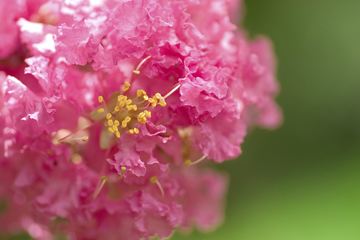Q. We replaced a big Ash tree with two Crape Myrtles. The pink blooming tree has five or six upward pointing branches. At the ends of the branches, are what I think are seedpods. The white Crape Myrtle has easily a dozen sideways/downward pointing branches and I’m a little concerned that the white Crape Myrtle will not have an upright growth habit, like it’s pink cousin. Will pruning and removing the seedpods cause the tree to grow upright? Also, what should I do to encourage the growth?
A. Crape Myrtle is a very popular summer blooming, deciduous tree although there are some varieties that flower in September. They’re a low to medium size tree that also produces some very nice fall color. The species has a number of varieties that have some distinct characteristics such as mildew resistant, large bold leaves, a stiff upright growth habit, and peeling bark, just too mention a few. Each species has a range of colors, so there are several whites, pinks, reds etc. From your description, you have two different varieties so the shape of these trees is not going to be mirror images of each other. Pruning will help but it’s not going erase the differences. Crape Myrtles are pruned during the winter months. They can be pruned severely, lightly or somewhere in between, it just doesn’t matter. On the white flowering variety, I’d look to remove the side growth keeping the larger upright branches and then fertilize to encourage the new growth. Fertilizer is also critical to each years blooming cycle as Crape Myrtles bloom only on the first year or current wood. Little to no new growth is the primary cause for the trees to stop blooming. With young trees, fertilize twice a year with 16-16-16. You would apply a half-pound of fertilizer per inch of trunk diameter measured two feet off the ground. It is spread under the drip line and not piled at the trunk of the tree. The first application can be done anytime after pruning through the end of March with the follow up feeding in May/June. With established tree, one application is all that is necessary. You’re correct that the structures at the ends of the Crape Myrtle stems are the seedpods. After flowering, a cluster of green, round seedpods form. They vary in size depending on the variety. The clusters mature in the late summer/early fall and then rupture. The seed is scattered around by the wind. Fortunately, they’re sterile, so they don’t become a nuisance popping up everywhere the next year. What left at the end of the stems is the brownish color casing that should be removed annually. After the flush of growth, I’d stand back a take a critical look at the canopy of the trees. If they continue to look dissimilar, I’d then consider replacing one before it gets too big. I’d check the label on the desirable tree for the correct variety. It should be available in white but probably not until late May.
Buzz Bertolero is Executive Vice President of Navlet’s Garden Centers and a California Certified Nursery Professional. His web address is www.dirtgardener.com and you can send questions by email at dirtgarden@aol.com or to 360 Civic Drive Ste. ‘D’, Pleasant Hill, Calif. 94523 and on Facebook at Facebook.com/Buzz.Bertolero
Leave a Reply